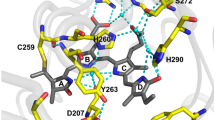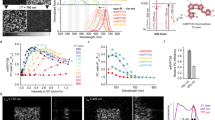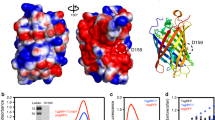Abstract
Far-red fluorescent proteins (FPs) are desirable for in vivo imaging because with these molecules less light is scattered, absorbed, or re-emitted by endogenous biomolecules compared with cyan, green, yellow, and orange FPs. We developed a new class of FP from an allophycocyanin α-subunit (APCα). Native APC requires a lyase to incorporate phycocyanobilin. The evolved FP, which we named small ultra-red FP (smURFP), covalently attaches a biliverdin (BV) chromophore without a lyase, and has 642/670-nm excitation–emission peaks, a large extinction coefficient (180,000 M−1cm−1) and quantum yield (18%), and photostability comparable to that of eGFP. smURFP has significantly greater BV incorporation rate and protein stability than the bacteriophytochrome (BPH) FPs. Moreover, BV supply is limited by membrane permeability, and smURFPs (but not BPH FPs) can incorporate a more membrane-permeant BV analog, making smURFP fluorescence comparable to that of FPs from jellyfish or coral. A far-red and near-infrared fluorescent cell cycle indicator was created with smURFP and a BPH FP.
This is a preview of subscription content, access via your institution
Access options
Subscribe to this journal
Receive 12 print issues and online access
$259.00 per year
only $21.58 per issue
Buy this article
- Purchase on Springer Link
- Instant access to full article PDF
Prices may be subject to local taxes which are calculated during checkout





Similar content being viewed by others
Change history
16 September 2016
In the version of this article initially published, Roger Y. Tsien was listed as the corresponding author. On account of his sad demise shortly after publication, Erik A. Rodriguez has been added as corresponding author. This has been updated in the HTML and PDF versions of the article.
References
Giepmans, B.N., Adams, S.R., Ellisman, M.H. & Tsien, R.Y. The fluorescent toolbox for assessing protein location and function. Science 312, 217–224 (2006).
Tsien, R.Y. Constructing and exploiting the fluorescent protein paintbox (Nobel lecture). Angew. Chem. Int. Edn. Engl. 48, 5612–5626 (2009).
Shaner, N.C., Steinbach, P.A. & Tsien, R.Y. A guide to choosing fluorescent proteins. Nat. Methods 2, 905–909 (2005).
Sakaue-Sawano, A. et al. Visualizing spatiotemporal dynamics of multicellular cell-cycle progression. Cell 132, 487–498 (2008).
Tsien, R.Y. The green fluorescent protein. Annu. Rev. Biochem. 67, 509–544 (1998).
Shaner, N.C. et al. Improved monomeric red, orange and yellow fluorescent proteins derived from Discosoma sp. red fluorescent protein. Nat. Biotechnol. 22, 1567–1572 (2004).
Moore, M.M., Oteng-Pabi, S.K., Pandelieva, A.T., Mayo, S.L. & Chica, R.A. Recovery of red fluorescent protein chromophore maturation deficiency through rational design. PLoS ONE 7, e52463 (2012).
Tubbs, J.L., Tainer, J.A. & Getzoff, E.D. Crystallographic structures of Discosoma red fluorescent protein with immature and mature chromophores: linking peptide bond trans-cis isomerization and acylimine formation in chromophore maturation. Biochemistry 44, 9833–9840 (2005).
Veal, E.A., Day, A.M. & Morgan, B.A. Hydrogen peroxide sensing and signaling. Mol. Cell 26, 1–14 (2007).
Hussain, S.P., Hofseth, L.J. & Harris, C.C. Radical causes of cancer. Nat. Rev. Cancer 3, 276–285 (2003).
Weitzman, S.A. & Gordon, L.I. Inflammation and cancer: role of phagocyte-generated oxidants in carcinogenesis. Blood 76, 655–663 (1990).
Barnham, K.J., Masters, C.L. & Bush, A.I. Neurodegenerative diseases and oxidative stress. Nat. Rev. Drug Discov. 3, 205–214 (2004).
Kumagai, A. et al. A bilirubin-inducible fluorescent protein from eel muscle. Cell 153, 1602–1611 (2013).
König, K. Multiphoton microscopy in life sciences. J. Microsc. 200, 83–104 (2000).
Shu, X. et al. Mammalian expression of infrared fluorescent proteins engineered from a bacterial phytochrome. Science 324, 804–807 (2009).
Filonov, G.S. et al. Bright and stable near-infrared fluorescent protein for in vivo imaging. Nat. Biotechnol. 29, 757–761 (2011).
Shcherbakova, D.M. & Verkhusha, V.V. Near-infrared fluorescent proteins for multicolor in vivo imaging. Nat. Methods 10, 751–754 (2013).
Yu, D. et al. An improved monomeric infrared fluorescent protein for neuronal and tumour brain imaging. Nat. Commun. 5, 3626 (2014).
Auldridge, M.E., Satyshur, K.A., Anstrom, D.M. & Forest, K.T. Structure-guided engineering enhances a phytochrome-based infrared fluorescent protein. J. Biol. Chem. 287, 7000–7009 (2012).
Fischer, A.J. & Lagarias, J.C. Harnessing phytochrome's glowing potential. Proc. Natl. Acad. Sci. USA 101, 17334–17339 (2004).
Yeh, S.W., Ong, L.J., Clark, J.H. & Glazer, A.N. Fluorescence properties of allophycocyanin and a crosslinked allophycocyanin trimer. Cytometry 8, 91–95 (1987).
Tooley, A.J., Cai, Y.A. & Glazer, A.N. Biosynthesis of a fluorescent cyanobacterial C-phycocyanin holo-α subunit in a heterologous host. Proc. Natl. Acad. Sci. USA 98, 10560–10565 (2001).
Zhang, J. et al. Fused-gene approach to photoswitchable and fluorescent biliproteins. Angew. Chem. Int. Edn. Engl. 49, 5456–5458 (2010).
Harris, J.W. & Kellermeyer, R.W. The Red Cell: Production, Metabolism, Destruction: Normal and Abnormal, Revised edn. (Harvard University Press, 1970).
Wahleithner, J.A., Li, L.M. & Lagarias, J.C. Expression and assembly of spectrally active recombinant holophytochrome. Proc. Natl. Acad. Sci. USA 88, 10387–10391 (1991).
Arciero, D.M., Bryant, D.A. & Glazer, A.N. In vitro attachment of bilins to apophycocyanin. I. Specific covalent adduct formation at cysteinyl residues involved in phycocyanobilin binding in C-phycocyanin. J. Biol. Chem. 263, 18343–18349 (1988).
Li, L., Murphy, J.T. & Lagarias, J.C. Continuous fluorescence assay of phytochrome assembly in vitro. Biochemistry 34, 7923–7930 (1995).
Katayama, H., Yamamoto, A., Mizushima, N., Yoshimori, T. & Miyawaki, A. GFP-like proteins stably accumulate in lysosomes. Cell Struct. Funct. 33, 1–12 (2008).
Chu, J. et al. Noninvasive intravital imaging of cellular differentiation with a bright red-excitable fluorescent protein. Nat. Methods 11, 572–578 (2014).
Stack, J.H., Whitney, M., Rodems, S.M. & Pollok, B.A. A ubiquitin-based tagging system for controlled modulation of protein stability. Nat. Biotechnol. 18, 1298–1302 (2000).
Sakaue-Sawano, A., Kobayashi, T., Ohtawa, K. & Miyawaki, A. Drug-induced cell cycle modulation leading to cell-cycle arrest, nuclear mis-segregation, or endoreplication. BMC Cell Biol. 12, 2 (2011).
Tomura, M. et al. Contrasting quiescent G0 phase with mitotic cell cycling in the mouse immune system. PLoS ONE 8, e73801 (2013).
Toettcher, J.E., Gong, D., Lim, W.A. & Weiner, O.D. Light control of plasma membrane recruitment using the Phy-PIF system. Methods Enzymol. 497, 409–423 (2011).
Gambetta, G.A. & Lagarias, J.C. Genetic engineering of phytochrome biosynthesis in bacteria. Proc. Natl. Acad. Sci. USA 98, 10566–10571 (2001).
Shu, X. et al. Mammalian expression of infrared fluorescent proteins engineered from a bacterial phytochrome. Science 324, 804–807 (2009).
Filonov, G.S. et al. Bright and stable near-infrared fluorescent protein for in vivo imaging. Nat. Biotechnol. 29, 757–761 (2011).
Shaner, N.C., Steinbach, P.A. & Tsien, R.Y. A guide to choosing fluorescent proteins. Nat. Methods 2, 905–909 (2005).
Arnold, K., Bordoli, L., Kopp, J. & Schwede, T. The SWISS-MODEL workspace: a web-based environment for protein structure homology modelling. Bioinformatics 22, 195–201 (2006).
Liu, J.Y., Jiang, T., Zhang, J.P. & Liang, D.C. Crystal structure of allophycocyanin from red algae Porphyra yezoensis at 2.2-Å resolution. J. Biol. Chem. 274, 16945–16952 (1999).
Schneidman-Duhovny, D., Inbar, Y., Nussinov, R. & Wolfson, H.J. PatchDock and SymmDock: servers for rigid and symmetric docking. Nucleic Acids Res. 33, W363–W367 (2005).
Andrusier, N., Nussinov, R. & Wolfson, H.J. FireDock: fast interaction refinement in molecular docking. Proteins 69, 139–159 (2007).
Larkin, M.A. et al. Clustal W and Clustal X version 2.0. Bioinformatics 23, 2947–2948 (2007).
Pettersen, E.F. et al. UCSF Chimera–a visualization system for exploratory research and analysis. J. Comput. Chem. 25, 1605–1612 (2004).
Wahleithner, J.A., Li, L.M. & Lagarias, J.C. Expression and assembly of spectrally active recombinant holophytochrome. Proc. Natl. Acad. Sci. USA 88, 10387–10391 (1991).
Lin, J.Y., Knutsen, P.M., Muller, A., Kleinfeld, D. & Tsien, R.Y. ReaChR: a red-shifted variant of channelrhodopsin enables deep transcranial optogenetic excitation. Nat. Neurosci. 16, 1499–1508 (2013).
Yu, D. et al. An improved monomeric infrared fluorescent protein for neuronal and tumour brain imaging. Nat. Commun. 5, 3626 (2014).
Schneider, C.A., Rasband, W.S. & Eliceiri, K.W. NIH Image to ImageJ: 25 years of image analysis. Nat. Methods 9, 671–675 (2012).
Acknowledgements
National Institute of General Medical Sciences Postdoctoral Fellowship F32GM089114 supported the project (E.A.R.). US National Institutes of Health grants GM086197 (R.Y.T.), NS027177 (R.Y.T.), NS090590 (J.Y.L.), and the Howard Hughes Medical Institute (R.Y.T.) supported the project. We thank P. Steinbach for measuring photostability, Q. Xiong for FACS, S. Adams for advice and experimental expertise, and P. Arcaira for help with mouse experiments. We thank M. Lin (Departments of Pediatrics and Bioengineering, Stanford, Stanford, CA) for iRFP713 vectors, M. Davidson (Addgene) for fusion vectors, and A. Miyawaki (Laboratory for Cell Function Dynamics, RIKEN Brain Science Institute, Wako, Japan) for FUCCI vectors. This paper is dedicated to the memory of Roger Tsien, who passed away shortly after it was published.
Author information
Authors and Affiliations
Contributions
E.A.R. and G.N.T. created bacterial expression plasmids, evolved and developed smURFP and APCαFPs in E. coli, and characterized properties. E.A.R. prepared mammalian plasmids, made the smURFP homology model, created TDsmURFP, performed BV incorporation rates, performed mammalian cell experiments (HO-1, different chromophores, protein stability, and FP photobleaching), created FR and NIR FUCCI, and performed fluorescence imaging in vitro and in vivo. J.Y.L. transduced neurons. E.A.R. and J.Y.L. created virus and stable HT1080 cells for mouse models. J.Y.L. and J.L.C. injected animals with cancer cells and chromophores. J.L.C. prepared plasma. E.A.R., G.N.T., and J.Y.L. purified PCB and analyzed data. L.A.G. performed MS. X.S. chose the Trichodesmium APCα gene and oversaw the first three rounds of evolution of APCα + PCB. R.Y.T. and E.A.R. oversaw the design and analysis of the experiments. All authors contributed to writing and discussion.
Corresponding authors
Ethics declarations
Competing interests
The authors declare no competing financial interests.
Supplementary information
Supplementary Text and Figures
Supplementary Figures 1–20 and Supplementary Tables 1–4 (PDF 28027 kb)
Time-lapse microscopy of mAG-hGem(1/110) and smURFP-hCdtI(30/120) FUCCI expressed in HEK293A cells.
Video is full field, 40X objective view of Supplementary Fig. 20 and total time is 70 h. mAG-hGem(1/110) and smURFP-hCdtI(30/120) fluorescence are shown in green and red, respectively. Green is EX / EM = 495(10) / 535(25) nm and red is EX / EX = 628(40) / 680(30) nm. EX is excitation and EM is emission. (MOV 7537 kb)
Time-lapse microscopy of FR and NIR FUCCI expressed in HEK293A cells.
Video is full field, 40X objective view of Fig. 5 and total time is 49 h. IFP2.0-hGem(1/110) and smURFP-hCdtI(30/120) fluorescence are shown in green and red, respectively. Green is EX / EM = 665(45) / 725(50) nm and red is EX / EX = 628(40) / 680(30) nm. EX is excitation and EM is emission. (MOV 5254 kb)
Rights and permissions
About this article
Cite this article
Rodriguez, E., Tran, G., Gross, L. et al. A far-red fluorescent protein evolved from a cyanobacterial phycobiliprotein. Nat Methods 13, 763–769 (2016). https://doi.org/10.1038/nmeth.3935
Received:
Accepted:
Published:
Issue Date:
DOI: https://doi.org/10.1038/nmeth.3935
This article is cited by
-
Near-infrared PAINT localization microscopy via chromophore replenishment of phytochrome-derived fluorescent tag
Communications Biology (2024)
-
Systematic comparison of nonviral gene delivery strategies for efficient co-expression of two transgenes in human mesenchymal stem cells
Journal of Biological Engineering (2023)
-
Quantitative assessment of near-infrared fluorescent proteins
Nature Methods (2023)
-
Structural and photophysical characterization of the small ultra-red fluorescent protein
Nature Communications (2023)
-
Caveat fluorophore: an insiders’ guide to small-molecule fluorescent labels
Nature Methods (2022)



